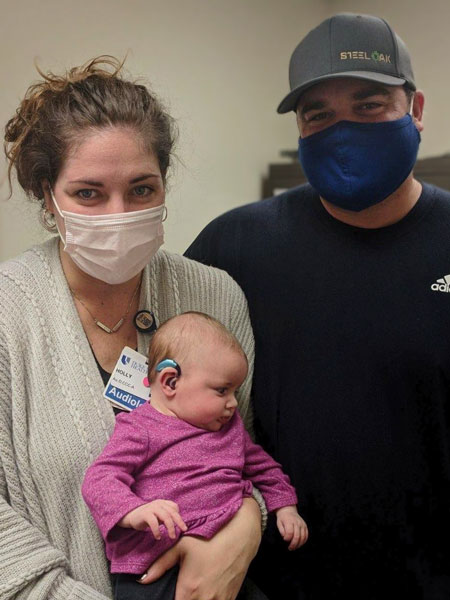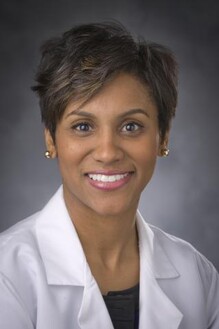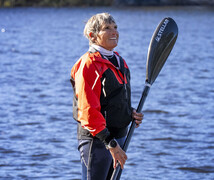Holly VanHorn was surprised to learn her newborn daughter Nessa needed a hearing aid. As an audiologist at Duke Health, VanHorn has been helping kids with hearing loss for more than a decade. Now she was the parent instead of the provider. VanHorn knew it would be challenging to manage a hearing aid in an infant, but the pros outweighed the cons. Today two-year-old Nessa is reaching speech milestones on schedule. “If Nessa didn't have her hearing aid to support her, I’m afraid she would be behind,” VanHorn said.
Newborn Hearing Screening Identifies Hearing Loss Early On
In October 2020, Holly VanHorn delivered twins -- a boy named Max and a girl named Nessa. Before being discharged, the twins underwent standard newborn hearing screenings. Max passed with flying colors. Nessa passed in one ear but not the other.
After more complex testing a few weeks later, results were the same. Duke audiologist Krista Roper, a long-time colleague and friend of VanHorn’s, shared the news that Nessa had mild to moderate hearing loss in her right ear. Tests ruled out common causes, adding Nessa to the half or more of children with no known reason for their hearing loss.
“It was interesting because I had never been on that side of it before,” VanHorn said. “All my years of experience working with families and kids with hearing loss kind of went away when it was my own child.”
Adjusting to Hearing Aids
Roper recommended that Nessa start using a hearing aid in her right ear. Without it, even with normal hearing in her left ear, Nessa could miss critical communication development opportunities. That’s because of a phenomenon called “binaural squelch,” according to Roper. “When we have hearing in two ears, we are better able to filter through background noise and hear individual people and sounds well. We can also determine where a sound is coming from,” she said. “When you have hearing loss on one side, this becomes more difficult.”
Treating Nessa’s hearing loss early would also help her reach important milestones. “When hearing loss is identified and treated within the first few months of life, children can stay on the same trajectory as their peers in communication and language development as well as educational outcomes,” Roper said.
Nessa was nearly three months old when she was fitted with her teal and purple hearing aid on December 31, 2020 (pictured). To the VanHorn’s surprise, it seemed like Nessa noticed a difference right away. “When we took her home that day, we were surprised at how much she was vocalizing. She was hearing herself in a different way,” VanHorn said.
It took a while for Nessa and her parents to adjust to life with a hearing aid. There were times the hearing aid would squeal if it got too close to something. It was heavy on Nessa’s tiny ear, so her parents used a special tape to hold it to her skin. As Nessa got older, she would often take out her hearing aid, try to put it in her mouth, throw it, or take it apart. It even ended up in the bathtub once. “It’s challenging to make sure a toddler keeps their hearing aid in their ear,” VanHorn said. “Whether they realize it's helping them or not, they just want to take it out and play with it.”
Now, thanks to time and consistency, Nessa asks for her hearing aid each morning when she’s getting ready for daycare. She calls it “Nessa’s hearing aid.” Like other toddlers her age, Nessa is learning new words and skills every day, and she loves to sing songs and dance with her brother. “It's fun to watch them interact and to know that Nessa’s hearing loss hasn't held her back,” VanHorn said.
A New Perspective
Experiencing hearing loss first-hand with her own child has allowed VanHorn to better relate to her patients. She shares tips and tricks that worked for her family.
She’s also thankful for how her colleagues cared for her family. “I work with this team daily, and I'm in awe of the way they treat patients. I'm so grateful, and I’m grateful that other families get to have that same experience.”






